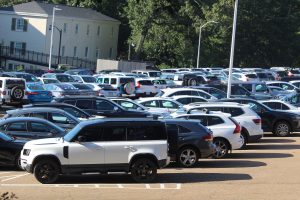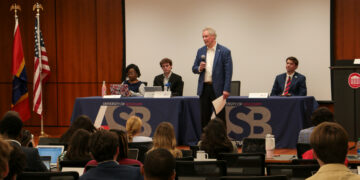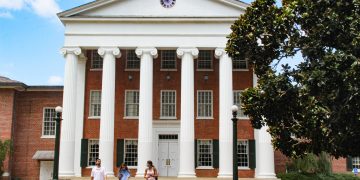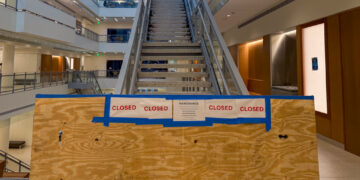
The University of Mississippi has sold almost 3,000 more parking passes than there are spaces available for students to park in. There are 14,960 total parking spaces available for students and faculty, including residential spaces, and 17,701 parking passes sold so far this year.
Hal Robinson, assistant director of parking and transportation systems, explained that this is by design — and further, that UM decreased the ratio of permits to spaces between this year and last.
“In fiscal year 2023 (last school year), we sold Commuter Blue permits at a ratio of 2.1-to-1, meaning we sold 2.1 parking permits per parking space,” Robinson said.
In the 2021-22 school year, the department sold passes at a 2-to-1 ratio and observed that some lots were not being fully utilized.
“Higher enrollment resulted in a much higher usage in fiscal year 2023 than anticipated, and the 2.1-to-1 ratio that year resulted in some excessive demand in some areas. This year, fiscal year 2024, we returned to a 2-to-1 ratio, which is the common standard rate for this type of parking zone,” Robinson said.
In 2022, UM welcomed the largest freshman class in university history on campus. That occurred again in 2023. According to students, these unprecedented enrollment numbers have exacerbated issues with finding parking spaces.
“It’s been so bad compared to last year that some people will park in areas that aren’t even parking spots. They’re not in the way of traffic, but they aren’t parked where they’re supposed to be,” Matthew Hearn, a senior computer engineering major, said. “They usually get tickets, but they don’t care because there’s not anywhere else to park.”
Hearn is far from alone. Libby Claire Jones, a junior math education major, laments purchasing one of the most expensive parking permits because she cannot find a space when she needs one.
“I have Commuter Blue. I feel like it’s a waste of money because there’s so many students on campus this year,” Jones said. “I could have just ridden the bus for free and gotten closer to some of my classes because most of the Blue spots are filled, and I have to park in the farthest ones.”
Aside from various residential parking designations, there are three parking pass options available for students living off-campus: Commuter Blue for $250, Commuter Red for $100 and a space in the pavilion parking garage for $550.
The extra $150 on the Commuter Blue price tag is justified by access to lots in closer proximity to buildings and classes on campus. Even those with Commuter Red parking passes, though, are feeling cramped.
“I have Commuter Red. It sucks sometimes, because last year, it was much easier. You might’ve had to park in the farthest spots, but at least you could find a spot in the first place,” Hearn said. “Now, I’m sometimes late to class because I have to wait for people to leave their parking spots so I can park.”
Robinson explained that the recent strain on parking has led the department to lower the permit-to-space ratio by 0.1% and that the department may consider lowering the rate even further next year.
“Fiscal year 2025 may see a further reduction of the rate based on what we are seeing this year so far,” he said.
Some parking pass holders are experiencing the strain more intensely than others. The Commuter Blue lots, which have a ratio of 2-to-1, are far above capacity, with 5,478 sales for 2,745 spaces. Commuter Red has no limiting ratio for how many passes can be sold, and there were 4,023 sales for 3,995 available spaces.
Additionally, the number of spaces sold for Commuter Red and Commuter Blue parking between the 2022-2023 school year and 2023-2024 changed significantly. The number of Commuter Blue parking passes sold decreased by 825, while sales for Commuter Red passes increased by 1,416.
Many of the Commuter Red spaces used to be considered Park-N-Ride spaces and are situated a significant distance from classes. University OUT buses still run between these routes.
For instance, according to Google Maps, the walk from the Commuter Red lot at the Jackson Avenue Center to Holman Hall, where the School of Business is located, is 23 minutes. The walk to George Peabody Hall is 26 minutes.
Another Commuter Red parking lot is located at the South Oxford Center at 2301 South Lamar Boulevard. A walk from the SOC to Holman Hall takes 50 minutes and crosses U.S. Highway 27. To George Peabody Hall, the walk takes 45 minutes, and to Guyton Hall, it is a 57-minute walk.
“It’s not reasonable to call that a commuter lot. I think there’s a problem with the labeling,” Ross Cohen, a junior accounting and public policy leadership major, said. “If the university wants to call it a commuter lot, they need to do more to make sure the buses are running efficiently on their routes.”
Kadi Van, a freshman biochemistry major, lives off campus and takes the bus to school.
“The buses are almost never on time. They are two to three minutes late on a good day, and 10 to 15 minutes on a bad day,” Van said. “The longest I’ve had to wait is 25 minutes.”
Ethan Wilchynski, a sophomore civil engineering major, shares Van’s experience.
“I usually wait 25 minutes for the bus,” he said.
However, Improvements are always in the works but things never seem to improve.
“It should hopefully be getting a little better, though. My bus driver told me that they should be adding another bus to the green line soon,” Wilchinsky said.
Similarly, the parking department is seeking to expand available parking. According to Robinson, though, these plans are limited by cost and land availability.
“Our department is always looking for options to develop more parking. Space is very limited though, and parking garages are extremely expensive,” Robinson said. “On average, it costs in excess of $30,000 per space to build a garage versus less than $5,000 per space to build a surface lot.”
However, Robinson guaranteed that a parking area will be built in conjunction with new dormitory buildings.
“Right now, we are in the planning stages to construct a new residential (parking) facility to accommodate expected demand created by the new housing facilities being built at the Kincannon Hall site,” he said.
The future of commuter lots lies in the number of students enrolled in UM. If the university continues to break admittance records, then faculty, staff and off-campus students could have another parking lot at their disposal.
“Additional parking options will be considered, but surface lot utilization at some of the outer lots (like the South Lot and the JAC) does not warrant the major expense of a new parking structure immediately for commuters and staff,” Robinson said. “That may change quickly depending on enrollment.”


























